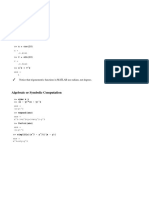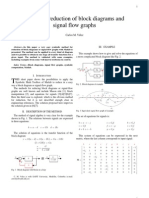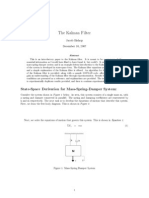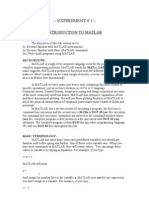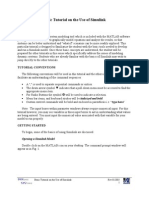0 ratings0% found this document useful (0 votes)
64 viewsMatlab Practical Assignments
This document contains code for two MATLAB programs. The first program defines a function called triplesinc that generates a baseband signal for AM modulation using a combination of sinc functions. The second program uses the triplesinc function to demonstrate double sideband (DSB) modulation and demodulation, multiplying the output of triplesinc by a cosine carrier signal and performing an FFT to recover the signal spectrum after modulation.
Uploaded by
zayarCopyright
© © All Rights Reserved
Available Formats
Download as TXT, PDF, TXT or read online on Scribd
0 ratings0% found this document useful (0 votes)
64 viewsMatlab Practical Assignments
This document contains code for two MATLAB programs. The first program defines a function called triplesinc that generates a baseband signal for AM modulation using a combination of sinc functions. The second program uses the triplesinc function to demonstrate double sideband (DSB) modulation and demodulation, multiplying the output of triplesinc by a cosine carrier signal and performing an FFT to recover the signal spectrum after modulation.
Uploaded by
zayarCopyright
© © All Rights Reserved
Available Formats
Download as TXT, PDF, TXT or read online on Scribd
You are on page 1/ 2
for program 1
%(triplesinc.m)
%Baseband signal for AM
%Usage m=triplesinc(t,Ta)
function m=triplesinc(t,Ta)
%t is the length of the signal
%Ta is the parameter,equaling twice the delay
%
sig_1=sinc(2*t/Ta);
sig_2=sinc(2*t/Ta-1);
sig_3=sinc(2*t/Ta+1);
m=2*sig_1+sig_2+sig_3;
end
for program 2
%(ExampleDSB.m)
%This program uses triplesinc.m to illustrate DSB modulation and demodulation
ts=1.e-4
t=-0.04:ts:0.04;
Ta=0.01;
m_sig=triplesinc(t,Ta);
Lfft=length(t); Lfft=2^ceil(log2(Lfft));
M_free=fftshift(m_sig,Lfft));
freqm=(-Lfft/2:Lfft/2-1)/(Lfft*ts);
s_dsb=m_sig.*cos(2*pi*500t);
Lfft=length (t); Lfft=2^ceil(log2(Lfft)+1);
S_dsb=fftshift(fft(s_dsb,Lfft));
freqs=(-Lfft/2:Lfft/2-1)/(Lfft*ts);
Trange=[-0.03 0.03 -2 2]
figure(1)
subplot(221);td1=plot(t,m_sig);
You might also like
- Project Progress Report: Summary of Progress (Including Any Problems)No ratings yetProject Progress Report: Summary of Progress (Including Any Problems)1 page
- Chapter 2: Introduction To MATLAB Programming ExercisesNo ratings yetChapter 2: Introduction To MATLAB Programming Exercises19 pages
- Lab Manual: Name Roll No. Year Batch Department100% (1)Lab Manual: Name Roll No. Year Batch Department64 pages
- Si Solar Cell 1D: Created in COMSOL Multiphysics 5.2aNo ratings yetSi Solar Cell 1D: Created in COMSOL Multiphysics 5.2a14 pages
- Matlab For Microeconometrics: Numerical Optimization: Nick Kuminoff Virginia Tech: Fall 2008No ratings yetMatlab For Microeconometrics: Numerical Optimization: Nick Kuminoff Virginia Tech: Fall 200816 pages
- Use COMSOL Multiphysics To Make A 2D Simulation of Poiseuille FlowNo ratings yetUse COMSOL Multiphysics To Make A 2D Simulation of Poiseuille Flow6 pages
- ECE 304: Open-And Short-Circuit Time ConstantsNo ratings yetECE 304: Open-And Short-Circuit Time Constants6 pages
- Jitter, Noise, and Signal Integrity at High-Speed: A Tutorial - Part IINo ratings yetJitter, Noise, and Signal Integrity at High-Speed: A Tutorial - Part II4 pages
- Nonlinear Programming 3rd Edition Theoretical Solutions ManualNo ratings yetNonlinear Programming 3rd Edition Theoretical Solutions Manual20 pages
- Matlab Programs For Elementary Signals: Unit Step FunctionNo ratings yetMatlab Programs For Elementary Signals: Unit Step Function3 pages
- Write A Mat Lab Program To Perform Linear and Circular Convolution of The Discrete Time Sequences X50% (2)Write A Mat Lab Program To Perform Linear and Circular Convolution of The Discrete Time Sequences X26 pages
- Instant Download Understanding Social Problems 7e 7th Edition Linda A. Mooney PDF All Chapters100% (11)Instant Download Understanding Social Problems 7e 7th Edition Linda A. Mooney PDF All Chapters70 pages
- Common Emitter Amplifier.: Experiment-1No ratings yetCommon Emitter Amplifier.: Experiment-147 pages
- The Kalman Filter: State-Space Derivation For Mass-Spring-Damper SystemNo ratings yetThe Kalman Filter: State-Space Derivation For Mass-Spring-Damper System10 pages
- [FREE PDF sample] Digital Modulations Using Matlab Build Simulation Models From Scratch black White Edition Viswanathan ebooks100% (3)[FREE PDF sample] Digital Modulations Using Matlab Build Simulation Models From Scratch black White Edition Viswanathan ebooks65 pages
- EE-361 Feedback Control Systems Introduction To Simulink and Data Acquisition Experiment # 2No ratings yetEE-361 Feedback Control Systems Introduction To Simulink and Data Acquisition Experiment # 223 pages
- Statistics For Biomedical Engineers and Scientists: How To Visualize and Analyze Data 1st Edition - Ebook PDF All Chapters Instant Download100% (3)Statistics For Biomedical Engineers and Scientists: How To Visualize and Analyze Data 1st Edition - Ebook PDF All Chapters Instant Download51 pages
- (FREE PDF Sample) Digital Signal Processing Using MATLAB 3rd Edition Vinay K. Ingle Ebooks100% (20)(FREE PDF Sample) Digital Signal Processing Using MATLAB 3rd Edition Vinay K. Ingle Ebooks84 pages
- Lab Report 6: Digital System and ProcessingNo ratings yetLab Report 6: Digital System and Processing8 pages
- Process Systems Analysis and Control: (3rd Edition)No ratings yetProcess Systems Analysis and Control: (3rd Edition)6 pages
- Modeling of Process IntensificationFrom EverandModeling of Process IntensificationFrerich J. KeilNo ratings yet
- Modeling of Digital Communication Systems Using SIMULINKFrom EverandModeling of Digital Communication Systems Using SIMULINKNo ratings yet
- Simulation of Some Power System, Control System and Power Electronics Case Studies Using Matlab and PowerWorld SimulatorFrom EverandSimulation of Some Power System, Control System and Power Electronics Case Studies Using Matlab and PowerWorld SimulatorNo ratings yet
- ECS 701 Communication Theory Lab Session: Wireless Communication Systems Simulation Using MATLABNo ratings yetECS 701 Communication Theory Lab Session: Wireless Communication Systems Simulation Using MATLAB13 pages
- Device Name (Sensors) Code No. Reference 4100Ks RDNY0054: Carbon Dioxide (CO2)No ratings yetDevice Name (Sensors) Code No. Reference 4100Ks RDNY0054: Carbon Dioxide (CO2)1 page
- Research Methodologies and Emerging Technologies (Cis013-3) : Dr. Htoo Maung Maung STI Myanmar UniversityNo ratings yetResearch Methodologies and Emerging Technologies (Cis013-3) : Dr. Htoo Maung Maung STI Myanmar University31 pages
- Pin Configuration & Components List Table: Mq137 (Ammonia) Nh3, Nox, Alcohol, Benzene, Smoke, Co2No ratings yetPin Configuration & Components List Table: Mq137 (Ammonia) Nh3, Nox, Alcohol, Benzene, Smoke, Co25 pages
- %trianglefunction Function End: 'Linewidth' 'Message Signal'No ratings yet%trianglefunction Function End: 'Linewidth' 'Message Signal'4 pages
- % (Exampleamdemfilt.M) : Y Triangl (T) Y (1-Abs (T) ) . (T - 1) . (T 1)No ratings yet% (Exampleamdemfilt.M) : Y Triangl (T) Y (1-Abs (T) ) . (T - 1) . (T 1)3 pages















